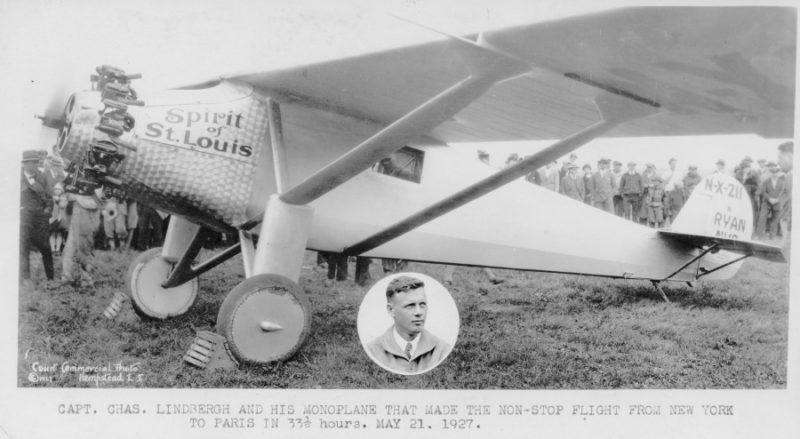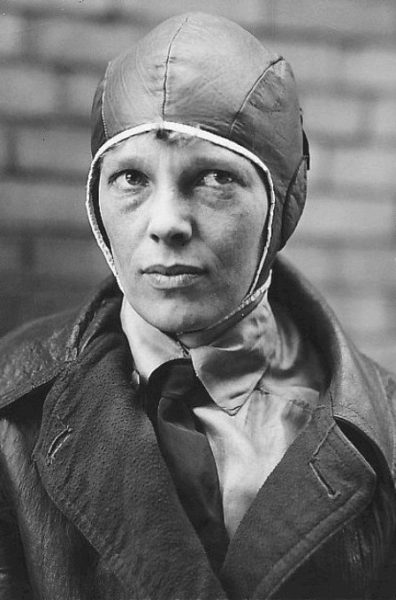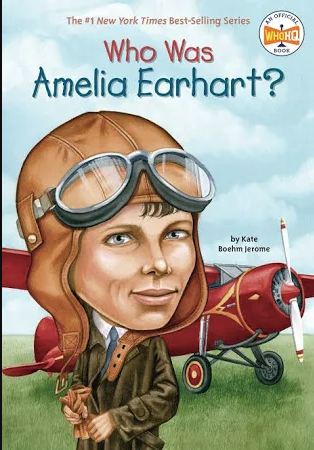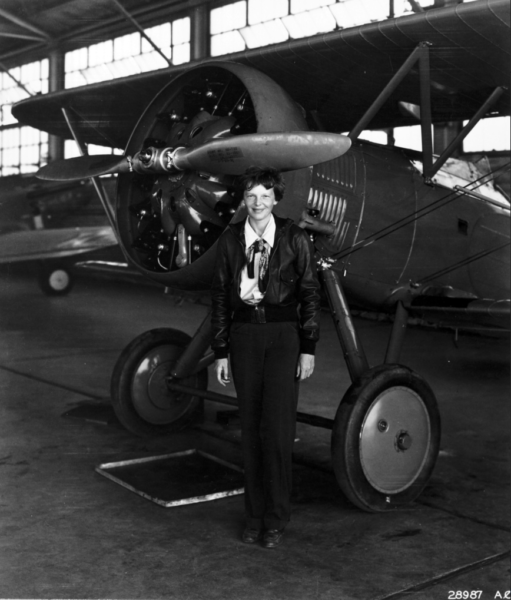One of the most curious facets of feminism is that many of its icons are fraudulently famous. It isn’t that women have never had major accomplishments, but that feminists usually promote the frauds over the genuine article.
In part 1, we saw how Margaret Hamilton, an entry-level programmer, was groomed by her future husband into a leadership position on the Apollo project. History would take the work of hundreds of men and treat it as if it was due to her brilliance alone, including many sources awarding her the credit for putting a man on the moon.

Margaret Hamilton is not the only woman to be treated as a feminist hero, with society assigning the accomplishments of others to her credit. Perhaps the most famous of these women is Amelia Earhart
Amelia Earhart
Wikipedia speaks quite positively of Earhart:
…
…
…

Charles Lindbergh was a pilot who, from a very early age, was interest in mechanized motor transport. He made his first flight in 1922. By 1926 he was a reserve officer, a captain, in the Missouri National Guard. In the next couple of years he worked as a pilot to deliver the U.S. mail. Then, in 1927 in an attempt to win the Orteig Prize, Lindbergh became the first person to make a solo flight—in the Spirit of St. Louis—across the Atlantic from Long Island to Paris, a distance of about 3,600 miles. Upon arrival, he was reportedly greeted by 150,000 people. This would be the start of his global fame.

Amelia Earhart began flying instruction in 1921. Her flight in 1922 set an altitude record… for a female. She got her pilots license in 1923, the 6,017th license to be issued by the International Aeronautics Federation and the 16th woman to do so in the United States. Then in 1928, she became the first woman to fly across the Atlantic ocean. Upon her return to the United States, she was celebrated with a parade in Manhattan and met with the president at the White House.
Given the fame of both at the time of their respective flights, why is Earhart now the most famous? It is not because of her merit—for Lindbergh did it first—but solely because she is a woman. Let’s see why, and if you don’t already know, you’re in for some surprises.
Publicity Stunts
While Lindbergh’s solo—low budget—flight was an achievement that no one had done before, Earhart was just a copy cat. So why did she do it and why did she become such a celebrity? Wikipedia tells the tale:
Shortly after Lindbergh’s ground-breaking flight, Amy Phipps Guest wanted to capitalize on Lindbergh’s success. She was the daughter of an American industrialist, wife of a prominent British politician, and a multi-billionare. Although she wanted the fame for herself, she was not a pilot and was far too wealthy and important to risk her own life as a passenger. So she sought out another girl “with the right image” for her little publicity stunt.
Now, remember when I said that Earhart was “the first woman to fly across the Atlantic ocean?” That thing for which she got a parade down the streets of Manhattan? That’s right, my friends, she did so as a passenger. As a pilot, she had no training whatsoever for such a flight.
The publicity stunt worked, of course. Off to the dustbin of history went pilot Wilmer Stultz and copilot/mechanic Louis Gordon, and into celebrity soared Earhart. She went on a speaking tour, published books, did product endorsements and had product lines named after her. She would eventually marry her publisher and publicist George Putnam, the same man who had selected and groomed her into celebrity status in the first place.
In 1932, five years after Lindbergh’s famous flight, she tried to replicate her own flight. She made it as far as Ireland, as mechanical problems forced her to land prematurely. Though a failure, this was, nonetheless, enough to technically become the first woman to pilot a solo transatlantic flight. She would receive a number of awards and medals as her fame grew even more.
She spent the next few years making flights for the purpose of setting woman’s flight records. But she had her sight on the biggest record of all: flying around the world. Because this had already been done by others, she set out to break the length record. She made one failed attempt, having had to call it off due to mechanical problems. She would make one more attempt. It would be her final publicity stunt as she did not arrive at her final destination, presumed dead from a crash, after (likely) running out of fuel, along with her copilot Fred Noonan.
Legacy

Death did not end Earhart’s celebrity nor harm her legacy at all. It only cemented her legendary status, almost like a martyr. To this day she is regarded as a feminist icon to inspire girls everywhere. I would not encourage my girls to emulate Earhart. A basic analysis of Earhart’s life reveals a life centered around self-promotion at the cost of men, not something anyone should strive to be.

She was first thrust into the spotlight because some people wanted to manufacture a celebrity in the wake of the fame of Charles Lindbergh, literally trying to take the spotlight off of him and put it onto a girl who was pre-selected for her looks, her star quality as it were, and, of course, chosen because she was a woman. The result was a legacy that cost men like Lindbergh, Stultz, and Gordon the credit they deserved in the history of aviation for the work they did.

Earhart’s attempt to circumnavigate the globe in a plane required the coordination and support of countless unnamed men, including the use of the U.S. Coast Guard equipment and manpower to assist in the stunt. Your taxpayer dollars at work! What makes Earhart’s attempt so offensive is not that she, as a woman, did what she did, but that it is portrayed as a victory just for women, not only minimizing the role of the many men that helped her, but treating men as if they stood in her way. To some feminists, men are to be vilified for their role in suppressing women, which in the case of Earhart is the most ridiculous thing imaginable.

Such things are indeed par for the course when it comes to celebrities in general. Famous people—both men and women—often have reputations that far outstrip their achievements. What makes Earhart more unique is that she represents feminism. An analysis of her life shows that, by and large, she was celebrated for being a woman and her flight achievements were just a means to that end. Had Earhart been a man, none of her achievements would have been remembered.
Feminists never say that women overcame their limitations and should be celebrated for lesser achievements because they are inferior to men. If they did, having their own leader-boards would make sense. But modern feminists do not believe that women are inferior to men in any way. Ask them! By logical implication, if being female is itself an achievement all on its own, then being female must make one superior, even when one underachieves. No wonder feminist icons are not icons due to their achievements!
Nobody is special just because they are a man or a woman. Had Earhart been a man, or an unmarketable looking woman, nothing she did would have been noteworthy, including her otherwise notable flights and her efforts to increase female participation in aviation. Moreover, her own work overshadowed the groundbreaking achievements of the all the firsts made by other women, including those of the women whose records Earhart beat. One can look at men like Einstein and Newton and say that they built their own greatness on the backs of the giants that came before them, but the same is never said of Earhart.
Amelia Earhart’s rise and subsequent stardom mirrors that of a parasite.
Such is the emptiness of being famous just because you are a woman. The truest insult is that had Putnam picked someone else, had Earhart not looked just right, her achievements would have been done by someone else. Amy Guest pulled from her billions to, essentially, purchase Earhart’s celebrity. These facts just trivialize her achievements. This is what feminism’s icons do: they trivialize achievement and merit, while emphasizing achieving success by having it handed to them or merely being a woman at the right place at the right time. It’s insulting.
In the final analysis, Earhart’s hubris got her and her copilot killed. Her achievements in flight were not especially notable without the asterisk “…for a woman.” Hubris, of course, is certainly not limited to women, but it is also not something to celebrate. Earhart’s life stands as a stark warning against hubris and against feminism in general.
Feminist Icon
As a feminist icon, there a number of interesting parallels between Margaret Hamilton and Amelia Earhart. Like Hamilton, Earhart married the man who was responsible for her rise. You know what they say, “behind every successful woman is the man who got her there.” Like Hamilton, Earhart is given the honor due and the credit for the achievements of men. Like Hamilton, the lie is subtly told of Earhart: that she piloted her first flight across the Atlantic, when in reality she was just an entry-level pilot who went as a glorified passenger. And just like Hamilton, had Earhart been a man, her achievements would not likely have been remembered at all.
I suspect that, like Hamilton, Earhart was probably a person that people—especially the men who so closely assisted her—genuinely truly liked. After all, if Earhart was merely a female Jerry Rice, chasing and breaking records for the fun of doing it, she would be cheered on by men and women alike. Everyone loves a vibrant record setter!
But Earhart’s legacy was co-opted by others for their own ends to create a goddess out of Earhart that the real Earhart could never hope to live up to. The purpose of these series is not to tarnish the reputation of these icons, nor their actual achievements, but to condemn the practice of (1) promoting women just because they are women; (2) exaggerating and lying about their accomplishments; and (3) stealing credit from men.
When I asked my children who Earhart and Lindbergh were, only one out of four could identify Lindbergh or his accomplishment. All could identify Amelia Earhart. One of them identified Amelia Earhart as “the first person to fly by themselves across the ocean.” When I told her that she was wrong and that this was actually Charles Lindbergh, she was displeased with my answer and, hilariously, threw a pencil eraser at me.
History should be taught as it actually happened, not because you need an icon to promote feminism. In Earhart’s first famous flight, she was a passenger. In her famous solo flight, she didn’t even succeed in making it to her planned destination. In her goal to fly around the world, she failed twice and it ultimately cost her life. It’s not hard to spin Earhart’s life in various positive ways, but this should not be done at the cost of truth, which is what feminism has done to her. The abuse of her legacy by feminists papering over her failures simply trivializes her positives.


Good writeup.
Heh, Mike’s old boss (recently retired, military and now a civilian pilot for United) is a member of the Lindberg family. Callsign “Louis”. 🙂
That was a funny anecdote about your daughter. LOL
Most people outside the aviation community aren’t familiar with the names of even the most famous pilots (exception perhaps the red baron…thanks to Snoopy).
Ironically (steps onto tiny soapbox) most of the truly greats would not be able to get past Captain today (if they made it that far). Not due to lack of skill obviously, but the PC police would intervene and they’d be thrown out. The cost of women entering the fighter pilot community. First they “just want to be like everyone else!” and “we’re no shrinking violets!” then it’s “this community is insulting, you need to be more inclusive and I’m offended”
…and the rest is history. What has been gained? Absolutely nothing.
Currently those fighter pilot songs, nose art images, “doofer” books (that document a long history of buffooneries), even a lot of the old photos of pilots during the war if any of them had an un-PC gesture in the image, are banned in squadron “heritage rooms” (aka bars…can’t even call them bars anymore).
https://x.com/liz97785652/status/1704116359842676771?s=20
Picture of a plane Dad landing in Vietnam after most of one of the wings had been shot off.
Mike was flying on American (think it American) a few months back and a little informational video came up at the beginning of the flight. It told the story of a little girl who just really wanted to be a pilot and…guess what?!? She flies for the airline now!
Nothing about being good at the job, experience level, et al..just a little girl and her dream.
Seems like an unsettling video for the passengers.
(sorry for the triple post, this topic gets me going)
Pingback: Limited Agency - Derek L. Ramsey